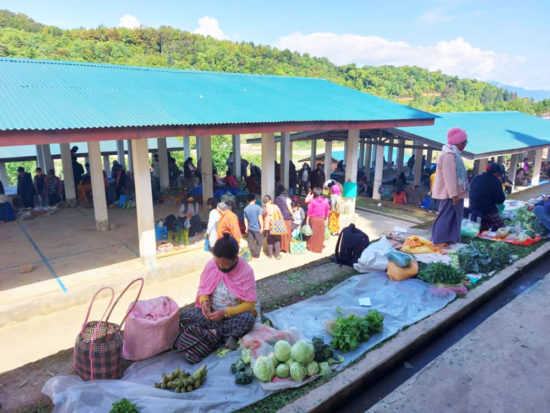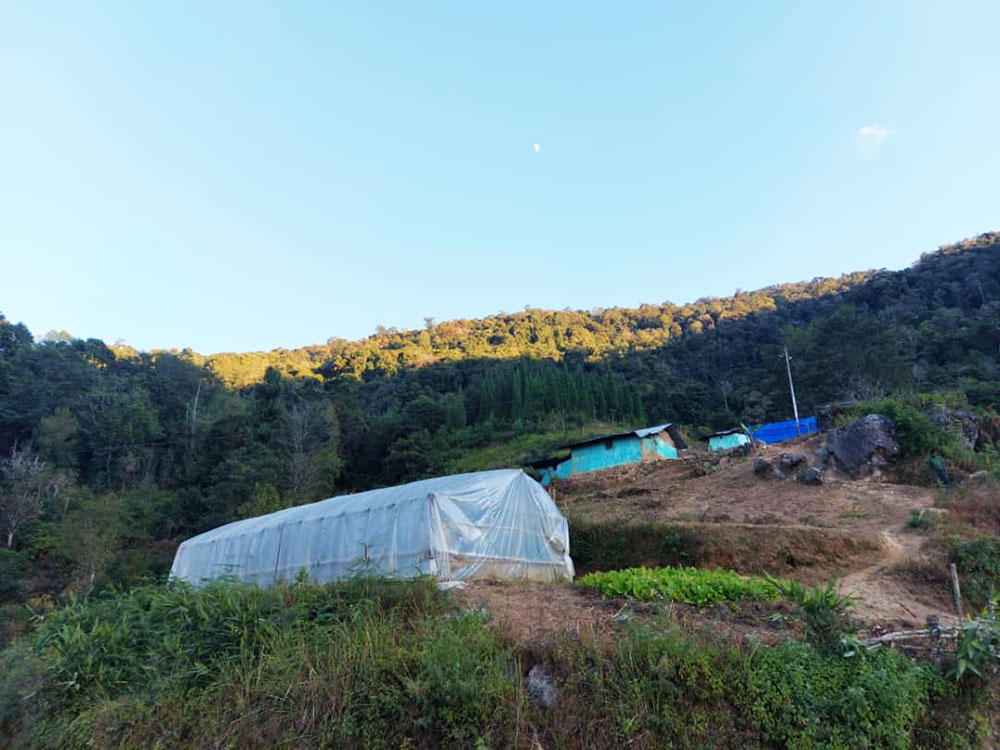Choki Wangmo | Tsirang
Members of the only community forest group in Kilkhorthang gewog, Tsirang started in 2008 with expectations of huge returns. However, after more than 14 years today, the 237 members of Phunsum Community Forest (PCF) have yet to enjoy bigger returns than harvesting construction timber.
According to members, there is no forest-based enterprise development such as handicrafts and woodworks due to the lack of road connectivity nearby. The water source for Kilkhorthang, Gosarling, and Tsholingkhar gewogs is located within the CF.
There are cardamon orchards and private land below the CF, impeding development in the CF that covers 745.3 acres.
Chairperson of PCF, Rinchen, said that the CF has no economically viable woods. He said that although people need 80 trees to build a house, the members are allotted only three to five trees each year. “To ensure equal distribution, we are cautious.”

Farmers sell forest produce at Damphu vegetable market
Every year, there are about 40 applicants for construction timber.
The CF members plant cypress and champ (Michelia spp. L) trees for high-quality timbers. “There were plans to plant bamboo but it was dropped as it requires constant care. Without access to the road, it would be challenging,” said Rinchen.
Besides the annual membership fee of Nu 100, the group is unable to generate income from the CF.
“In other CFs, people carry out commercial ventures from the CFs. Sale of excess timber and firewood, for example,” said Rinchen, adding that non-timber forest products such as mushrooms, ferns and wild asparagus in the CF are limited and people have to collect these products from government-reserved forests.
A forest ranger at the Tsirang forest division, Yoginidhi Chapagai, said that as the CF is far from the road point, any commercial production from the CF is not an option. “People can collect fodder, firewood, and timber on a subsistence level.”
The area is also crucial as it is a water source for people, he said, adding that they had been conserving the water sources.
The chief forestry officer of the Social Forestry and Extension Division, Karma Jigme Temphel, said: “CFs are a good source of drinking or irrigation water. We cannot allow harvesting and operation of timber logging at the source of water, which has negative impacts on the quality and quantity of water.”
Community Forest Management Groups (CFMGS) are compensated for the provision of services like drinking water to a nearby town from a water source within its forest. However, PCF did not get such benefits.
In many CFs, economic benefits have started flowing to the members with income generated from the sale of timber and non-wood forest products (NWFPs). The members use forest products for their own use and are entitled to market products if their own demand is satisfied.
NWFPs are bamboo species, cane species, daphne species, pipla (Piper species), lemongrass (Cymbopogon flexuosus), Bhutan Star Anise (Illicium griffithii), species of mushroom and chirata (Swertia chirayita).
“People living away from the CF cannot even harvest firewood, fuel, and fodder for self-consumption,” said the chairperson.
None of the members received skills development training to start commercial production from the CF.
Background of CFs in the country
The concept of people’s participation in sustainable forest management in Bhutan started with a Royal decree in 1979. People-oriented forestry programmes aimed at sustainable utilisation of forest resources for income generation and enhancement of livelihoods further received more focus since the early 1990s.
The first CF, Dozam in Drametse, Mongar was established in 1997. As of May 2021, there are 831 CFs, 34400 rural households and covering 106,135 hectares of forest land (3.9 percent of forest area).
The Forest and Nature Conservation Act of 1995 established the legal basis for community forestry through the Social Forestry Programme. Water source protection is also often included in the management plans for community forests.
KJ Temphel said that the CF programme was started for sustainable management of the forest resources; the CFMG members benefited through easy and affordable access to timber and NWFP resources.
More than 30 percent of the total number of CFs (840 CFs), he said, have generated cash income from the sale of the CF products, either timber, NWFP, or through services. “But more significantly, more than 80 percent of total CF are benefitting their CFMG members.”
Women participation in PCF
There is an equal number of male and female members in the PCF. However, of the four leadership positions, three are occupied by men. Only the CF audit is looked after by a female member.
A study reported that female members in Bhutan attended CF meetings and had as much knowledge of CF administration as men, and were more likely than men to represent their households in the CFMG. “Women’s influence in the CF management committees was limited, as they consistently held junior committee positions rather than the key positions of chairman and secretary.”
Women in Satsangma chiwog collected NWFP such as ferns and mushrooms from June to July every year.
Bakti Maya Monger said that the collection of NWFPs is on a small scale that involves risks and hard work. Attacks from wild animals, she said, are imminent.
In two months, she earns about Nu 6,000 from the sale of ferns and mushrooms at the vegetable market in Damphu.
People in the locality depend on vegetables, cardamom, and mung beans.
“To date, we haven’t been able to benefit from the CF but we look forward to changes in the future,” she said, adding that joining CF had helped many people get easy access to timber for constructing and maintaining houses and sheds.
Meena Maya Guragi from Menchuna said that she lives away from the CF and cannot collect NWFPs as there is no road connectivity. “Those people near the CF collect ferns and mushrooms.”
Lachi Maya from Satsangma is a new member of the group. “I am not familiar with CF rules yet. But I hope we will be able to improve the CF.”
Karma Jigme Temphel said that there is no exclusive provision focused on women but the National Forest Policy of Bhutan, 2011, provides opportunities to all the CFMG members. “The CF is managed based on principles of good governance to ensure transparency, accountability, inclusiveness, empowerment, equity and benefit sharing.”
To encourage more participation of women members in decision-making, he said the CF management committee must have a good representation of men and women.
With the highest number of CFs in the country, Tsirang has 50 approved CFs covering 9812.58 ha, benefitting 3,009 households. Sergithang, Dunglagang, Padtshaling gewogs have the highest number of CFs (six each).
This article is funded by JAB’s Rural Reporting Grant, supported by the Canada Fund for Local Initiatives


